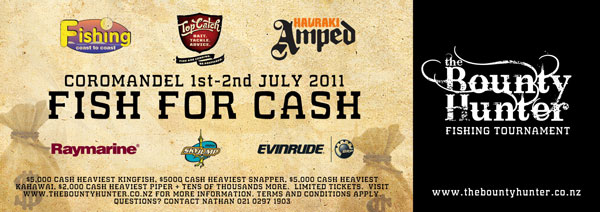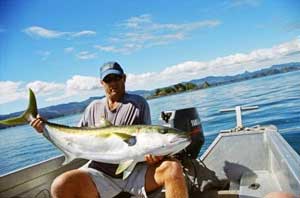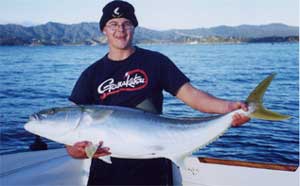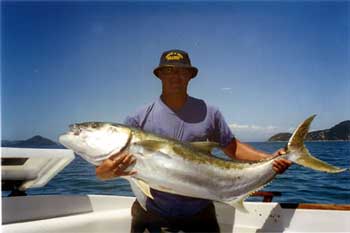|
By Tournament Director Milan Radonich
We believed the Coromandel has been needing a really great fishing contest for years now and it has been a challenge that we, as organisers of The Bounty Hunter, were delighted to pick up.
With extensive local knowledge it was obvious, the middle of winter, when all the big kingfish move in, has to be the absolute best time for the contest.
Coromandel has an amazing fishery and during the winter months the smaller fish move out into deeper water while big kingfish move in.
It is usually the time weather patterns settle down, the wind stops blowing and conditions are perfect for a fishing tournament!
We also decided we wanted a fishing tournament for serious anglers, no average weights, and your ticket number will not win a boat in our fishing contest.
Below the tournament info is a step-by-step guide on how to target really big kingfish around Coromandel.
These kingfish techniques will also be relevant for the Hauraki Gulf.
 |
THE BOUNTY HUNTER
WHEN
- Briefing night – 7.30pm June 30th 2011
- Fishing days – Friday 1st July & Saturday 2nd July 2011
WHERE
The Top Pub Coromandel, New Zealand
TICKETS:
$125 Standard Ticket.
Tickets Available Online at Bounty Hunters website with your credit card and delivered by mail to your address.
FISHING BOUNDARIES & TIMES
Refer to the map below for the areas allowed to fish. Contestants will be disqualified if caught fishing outside the boundaries.
Please make sure there you are clear on these boundaries.
Fishing starts 5.00am Friday 1st July and finishes Saturday 2nd July 5.00pm.
FOR MORE INFORMATION VISIT :
http://thebountyhunter.co.nz
THE TOURNAMENT
The Bounty Hunter has been set up for anglers to come and enjoy a weekend away in the coromandel, either with family or friends.
With most Fishing tournaments being held in the summer time, we wanted to give the anglers a great opportunity to get away during the winter when the fishing can be at its best in the Coromandel.
The Bounty Hunter is a Tournament that is all about rewarding anglers for their fishing efforts with fantastic prizes, and nothing’s better than cash.
The Top Pub in Coromandel town was chosen for the venue due to its warm cosy atmosphere, where competitors could sit back and relax with friends after a enjoyable day on the water.
The Bounty Hunter Fishing Tournament is going to be one not to be missed, it would be great to see you all there to help us promote and grow this cool and fantastic new Tournament.
Remember to keep an eye on the website as we hope to keep on increasing the prize pool as ticket sales continue.
Milan Radonich |
 |
Fishing Areas

Yellowtail Kingfish Tackle
-
 Mustad and Gamakatsu Live-Bait Hooks size 9/0 to 11/0 work very well. Mustad and Gamakatsu Live-Bait Hooks size 9/0 to 11/0 work very well.
- 80-100lb whiplash braid is a great investment for landing really big kingfish.
- Berkley Trilene Flurocarbon Trace works very well as it is invisible to kingfish.
Over the last 20 years I have spent a lot of time exploring the many small islands and harbours that the Coromandel has to offer.
Each new area we explored had a different time of day for when the kingfish turned up to feed.
It takes a while to learn but after a while you can start to read the patterns.
 My general rule of thumb now is to fish the big islands and the mainland, these areas seem to hold the bigger fish with fewer juveniles. My general rule of thumb now is to fish the big islands and the mainland, these areas seem to hold the bigger fish with fewer juveniles.
I have found that these areas with stronger currents seem to hold most of the big kingfish populations.
Finding this bite time is a must and keeping a kingfish diary could be very useful for this.
It's not uncommon to see the same fish every two to three hours and on the second or third sighting, after passing your bait several times and showing no interest, it will then decide to nail your live bait.
I have also found that many of the fish in this area appear to be resident, if you fish a particular spot one day it sometimes takes two to three days for the fish to get back into their routine after being spooked.
With these kingfish being resident, try and practice catch and release.
Finding the Bait.
 When chasing kingfish I find it easiest to target bait fish first thing in the morning. When chasing kingfish I find it easiest to target bait fish first thing in the morning.
I have spent days pulling my hair out watching kingfish at the back of the boat knowing that if I only had a live-bait it would be all on.
I find it useful to have a range of baitfish such as yellowtail mackerel, yellow-eyed mullet, kahawai, squid and piper.
The last three are the ultimate kingfish bait.
All of these should be easy to find in sheltered, still bays early in the morning, and the bigger the live bait the better.

You will need a live bait tank, a large one if you want a full day's supply of live bait, and with extra room if you want to keep kahawai alive.
Make sure the water is well aerated in the live bait tank and change the water regularly.
I must admit that all the big kingfish I have caught have been on huge kahawai or squid baits.
Once the live bait baits are swimming in the tank it is time to rig the baits.
Rigging and Placing Kingfish Baits
There are many ways to catch kings but the best way I've found is rigging with two meters of 80lb fluorocarbon trace with a game swivel one end and a live bait hook at the other.
For rigging live kahawai I use a 9/0 – 11/0 live bait hook or bigger. 
When using piper or yellow-eyed mullet live baits I prefer to use an octopus 6/0 fish hook as they are light-weight and don't drag the bait down as much as heavier hooks.
There is of course a lot of gear to choose from, but I believe the Gamakatsu and mustard brands of hooks have a wicked hook up rate and don't break or bend like some other hooks do.
When fishing for yellowtail kingfish with balloons, I use small water balloons as I have found the wind drag on bigger balloons can sometimes put too much stress on the livebait.
On very big kahawai I use party balloons. I push the balloons off though the top eye of the swivel as this will reduce the chances of tangles.
Once the live bait rig is finished, place the hook just in front of the top fin and on an angle so that the barb is facing forward. If there is low current piper live better being hooked in the anal area.
 The live bait is now ready to drop over the side and this is when the fun begins. The live bait is now ready to drop over the side and this is when the fun begins.
The live bait is going to want to swim under the boat, around the prop, the boarding ladder, the anchor and around the other lines that are out.
Wait until you get one set in a nice pattern out the back of the boat before deploying the next bait.
I like to run two live baits, one out far and one in close, just to cover all bases.
This is when some people give up on live bait fishing because it is necessary to keep an eye on both live baits. The moment you look away you can guarantee they will manage to find each other and twist up or wind themselves around some part of the boat!
This can be very frustrating but be patient and bear with it, it's worth the hassle!
The best advice I could give is to target kingies and kingies only.
Sometimes I fish a snapper rod as well but always remember that when the live bait gets struck, you are going to have to work fast.
Fewer rods in the water will make life so much easier.
Setting The Hook And Playing Kingfish
The hardest and most exciting part of kingie fishing is the strike. Sometimes they will just inhale the bait while passing by doing a million miles an hour. Other times they will come and try to scale your live bait and muck around before swallowing.
At this time all that has been read and learned from fellow fisho's normally goes out the window. The heart races and the palms begin to sweat.
Generally at the strike I turn the ratchet off, the reel should already be in free spool, I thumb the line
while counting to four, point the rod at the fish, push the reel into gear, wait for the line to come up tight and then strike the rod back as hard as I can - and pray that all the gear is in top order because this is when the fish hits high gear and the
reel starts to scream.

|